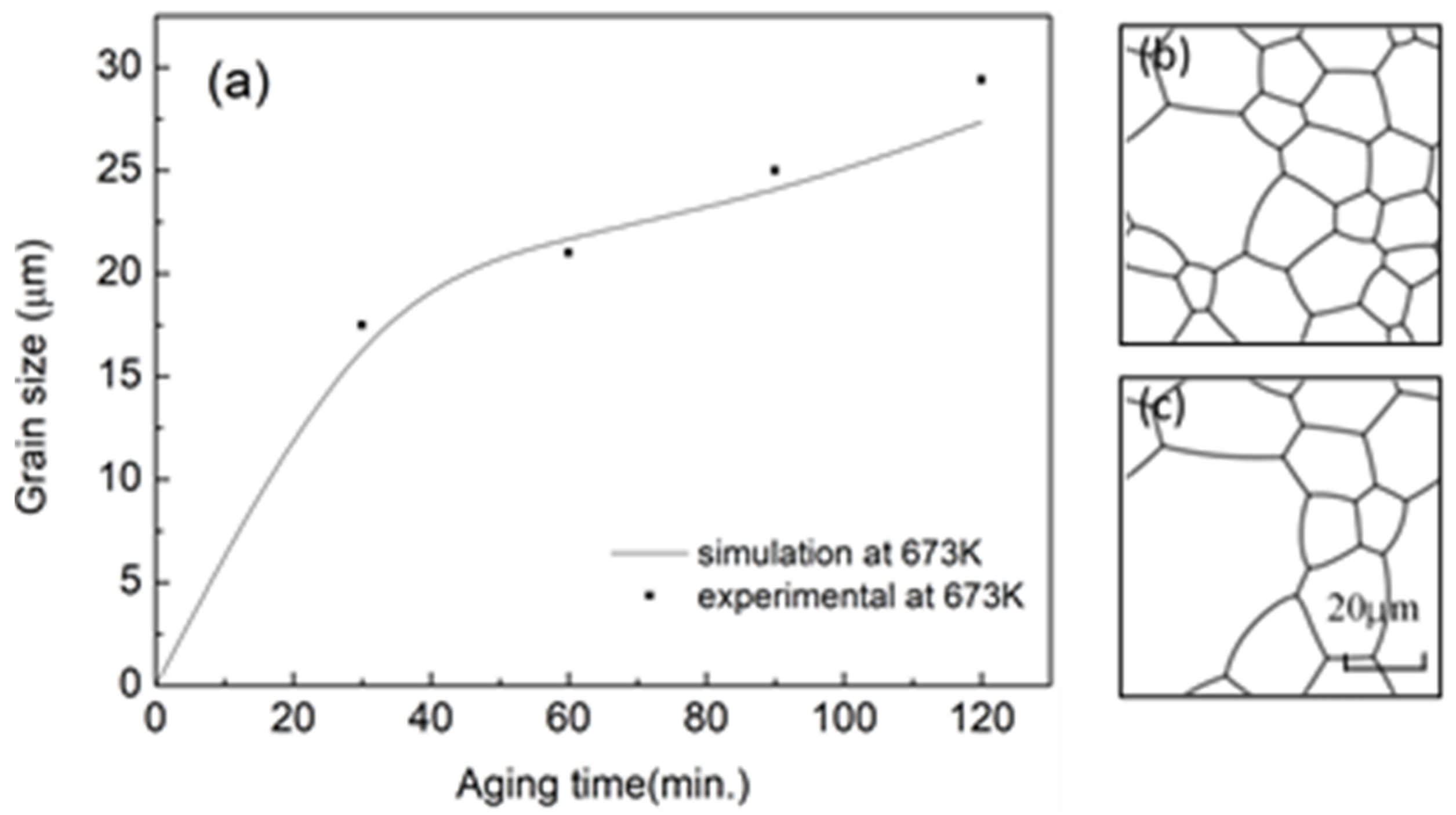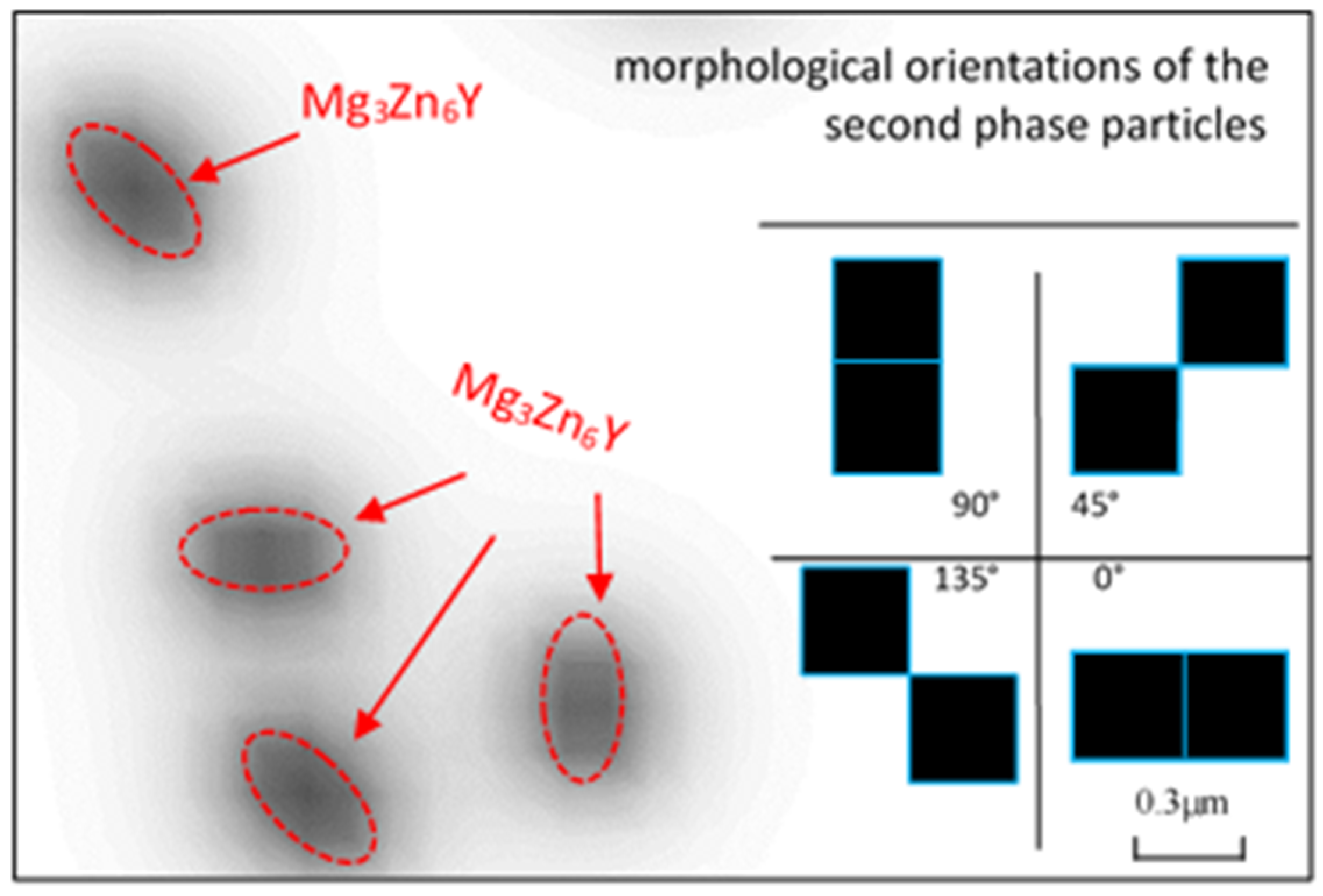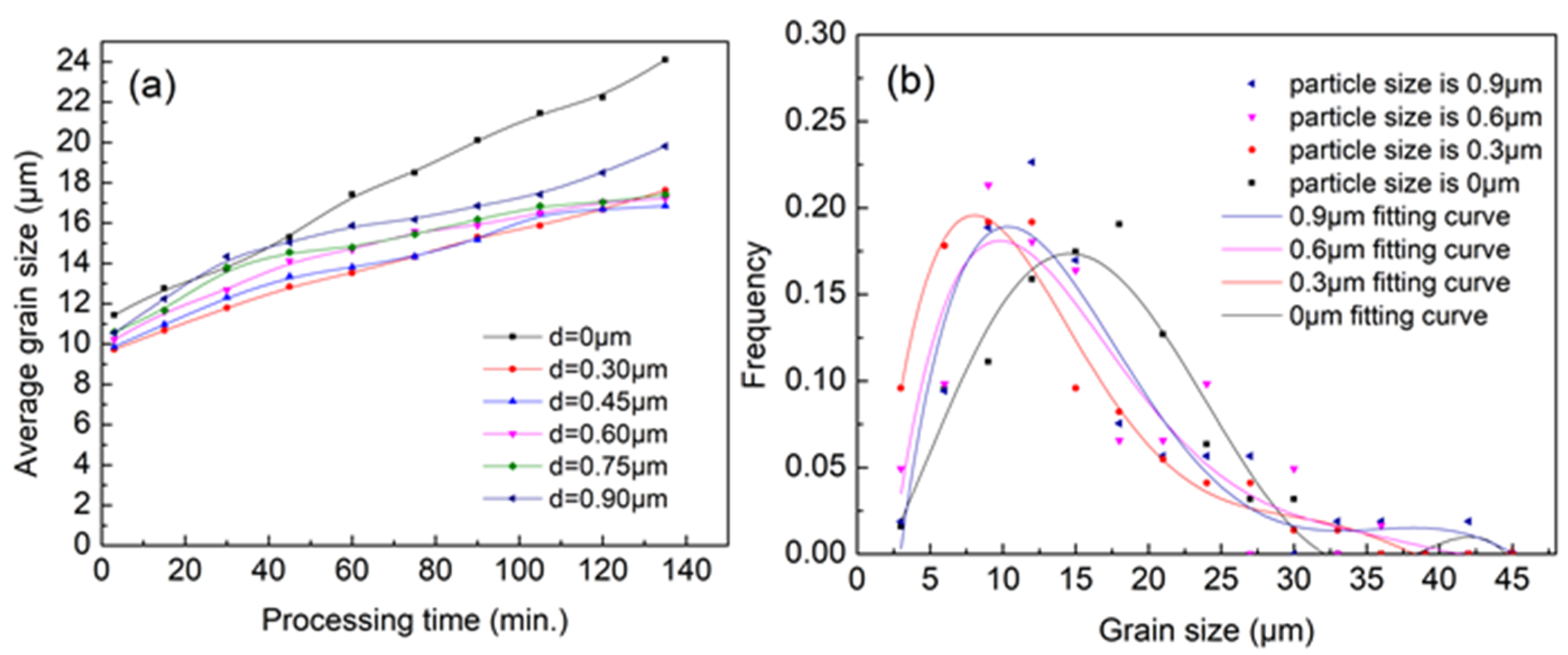Grain Refinement by Second Phase Particles under Applied Stress in ZK60 Mg Alloy with Y through Phase Field Simulation
Abstract
:1. Introduction
2. Model and Parameters
2.1. Phase Model with Second Phase Particles and Elastic Energy
2.2. Model Parameters Setting and Initial Condition
3. Result and Analysis
3.1. Recrystallization
3.2. Recrystallization with Second Phase Particles
3.3. Applied Stress
4. Conclusions
- The grain growth with the second phase particles and applied stress existing during annealing process was simulated on industrial scale on the condition of real time-space by a phase field method.
- The second phase particles have a promoting effect on the grain refinement; however, the effect weakened significantly when the content exceeded 1.5%. When the content is 1.5%, there exists a critical range of second phase particle size 0.3–0.45 μm, within which a microstructure of fine grains can be obtained.
- Applied stress can increase the grain coarsening rate significantly when the stress is more than 135 MPa. Moreover, second phase particles also have a significant refinement effect with the existence of applied stress. As to the critical size of the second phase particles, a critical range for the second phase particles, 0.4–0.75 μm, still exits under an applied stress of 135 MPa.
- A microstructure with a grain size of 11.8–13.8 μm on average can be obtained when the second phase particles have a content of 1.5% and a size of 0.4–0.75 μm with an applied stress less than 135 MPa after 30 min annealing at 573 K.
Author Contributions
Funding
Conflicts of Interest
References
- Liu, Z. Theoretical Basis and Application of Magnesium Based Light Alloy; China Machine Press: Beijing, China, 2002. [Google Scholar]
- Wang, B.; Yi, D.Q.; Wu, C.P.; Luo, W.H.; Fang, X.Y.; Liu, H.Q. Effect of yttrium on microstructure and properties of ZK60 sheet in annealing states. Chin. J. Nonferrous Met. 2008, 10, 1831–1838. (In Chinese) [Google Scholar]
- Kwak, T.Y.; Kim, W.J. Mechanical properties and Hall-Petch relationship of the extruded Mg-Zn-Y alloys with different volume fractions of icosahedral phase. J. Alloys Compd. 2019, 770, 589–599. [Google Scholar] [CrossRef]
- Singh, A.; Osawa, Y.; Somekawa, H.; Mukai, T. Effect of microstructure on strength and ductility of high strength quasicrystal phase dispersed Mg–Zn–Y alloys. Mater. Sci. Eng. A 2014, 611, 242–251. [Google Scholar] [CrossRef]
- Vinogradov, A.; Orlov, D.; Estrin, Y. Improvement of fatigue strength of a Mg–Zn–Zr alloy by integrated extrusion and equal-channel angular pressing. Scr. Mater. 2012, 2, 209–212. [Google Scholar] [CrossRef]
- Vasilev, E.; Linderov, M.; Nugmanov, D.; Sitdikov, O.; Markushev, M.; Vinogradov, A. Fatigue Performance of Mg-Zn-Zr Alloy Processed by Hot Severe Plastic Deformation. Metals 2015, 4, 2316–2327. [Google Scholar] [CrossRef]
- Allain, S.Y.P.; Aoued, S.; Quintin-Poulon, A.; Goune, M.; Danoix, F.; Hell, J.C.; Bouzat, M.; Soler, M.; Geandier, G. In Situ Investigation of the Iron Carbide Precipitation Process in a Fe-C-Mn-Si Q&P Steel. Materials 2018, 11, 1087. [Google Scholar]
- Zhao, C.; Zhang, W.; Wang, Z.; Li, D.; Luo, Z.; Yang, C.; Zhang, D. Improving the Mechanical Properties of Cu-15Ni-8Sn Alloys by Addition of Titanium. Materials 2017, 10, 1038. [Google Scholar] [CrossRef] [PubMed]
- Osuch, P.; Walkowicz, M.; Knych, T.; Dymek, S. Impact of the Direct Ageing Procedure on the Age Hardening Response of Al-Mg-Si 6101 Alloy. Materials 2018, 11, 1239. [Google Scholar] [CrossRef] [PubMed]
- Kennedy, J.R.; Rouat, B.; Daloz, D.; Bouzy, E.; Zollinger, J. Effect of Inoculant Alloy Selection and Particle Size on Efficiency of Isomorphic Inoculation of Ti-Al. Materials 2018, 11, 666. [Google Scholar] [CrossRef] [PubMed]
- Tan, Y.; Maniatty, A.M.; Zheng, C.; Wen, J.T. Monte Carlo grain growth modeling with local temperature gradients. Modell. Simul. Mater. Sci. Eng. 2017, 25, 065003. [Google Scholar] [CrossRef]
- Patterson, B.R.; Rowenhorst, D.J.; Tikare, V.; DeHoff, R.T.; Kaub, T.M. Affinities for topological arrangements in grain structures. Acta Mater. 2014, 79, 411–420. [Google Scholar] [CrossRef]
- Couturier, G.; Doherty, R.; Maurice, C.; Fortunier, R. 3D finite element simulation of the inhibition of normal grain growth by particles. Acta Materialia 2005, 53, 977–989. [Google Scholar] [CrossRef]
- Hallberg, H. Approaches to Modeling of Recrystallization. Metals 2011, 1, 16–48. [Google Scholar] [CrossRef] [Green Version]
- Kim, D.-U.; Cha, P.-R.; Kim, S.G.; Kim, W.T.; Cho, J.; Han, H.-N.; Lee, H.-J.; Kim, J. Effect of micro-elasticity on grain growth and texture evolution: A phase field grain growth simulation. Comput. Mater. Sci. 2012, 56, 58–68. [Google Scholar] [CrossRef]
- Yadav, A.K.; Nelson, C.T.; Hsu, S.L.; Hong, Z.; Clarkson, J.D.; Schleputz, C.M.; Damodaran, A.R.; Shafer, P.; Arenholz, E.; Dedon, L.R.; et al. Corrigendum: Observation of polar vortices in oxide superlattices. Nature 2016, 534, 138. [Google Scholar] [CrossRef] [PubMed]
- Tonks, M.; Millett, P. Phase field simulations of elastic deformation-driven grain growth in 2D copper polycrystals. Mater. Sci. Eng. A 2011, 528, 4086–4091. [Google Scholar] [CrossRef]
- Moelans, N.; Blanpain, B.; Wollants, P. A phase field model for the simulation of grain growth in materials containing finely dispersed incoherent second-phase particles. Acta Mater. 2005, 53, 1771–1781. [Google Scholar] [CrossRef]
- Chang, K.; Kwon, J.; Rhee, C.-K. Role of second-phase particle morphology on 3D grain growth: A phase-field approach. Comput. Mater. Sci. 2016, 124, 438–443. [Google Scholar] [CrossRef]
- Chang, K.; Moelans, N. Phase-field simulations of the interaction between a grain boundary and an evolving second-phase particle. Philos. Mag. Lett. 2015, 95, 202–210. [Google Scholar] [CrossRef] [Green Version]
- Chang, K.; Feng, W.; Chen, L.-Q. Effect of second-phase particle morphology on grain growth kinetics. Acta Mater. 2009, 57, 5229–5236. [Google Scholar] [CrossRef]
- Chang, K.; Chen, L.-Q. Quantitative evaluation of particle pinning force on a grain boundary using the phase-field method. Modell. Simul. Mater. Sci. Eng. 2012, 20, 055004. [Google Scholar] [CrossRef]
- He, R.; Wang, M.T.; Zhang, X.G.; Zong, B.Y. Influence of second-phase particles on grain growth in AZ31 magnesium alloy during equal channel angular pressing by phase field simulation. Modell. Simul. Mater. Sci. Eng. 2016, 24, 055017. [Google Scholar] [CrossRef]
- Wen, Y.H.; Wang, Y.; Chen, L.Q. Influence of an applied strain field on microstructural evolution during the α2 → O-phase transformation in Ti–Al–Nb system. Acta Mater. 2001, 49, 13–20. [Google Scholar] [CrossRef]
- Guo, W.; Steinbach, I.; Somsen, C.; Eggeler, G. On the effect of superimposed external stresses on the nucleation and growth of Ni 4 Ti 3 particles: A parametric phase field study. Acta Mater. 2011, 59, 3287–3296. [Google Scholar] [CrossRef]
- Wang, M.T.; Zong, B.Y.; Wang, G. Grain growth in AZ31 Mg alloy during recrystallization at different temperatures by phase field simulation. Comput. Mater. Sci. 2009, 45, 217–222. [Google Scholar] [CrossRef]
- Ginzburg, V.L.; Landau, L.D. On the Theory of Superconductivity. In Collected Papers of L.D. Landau; Pergamon Press: Oxford, UK, 1965. [Google Scholar]
- Cahn, J.W.; Hilliard, J.E. Free Energy of a Nonuniform System. I. Interfacial Free Energy. J. Chem. Phys. 1959, 31, 688–699. [Google Scholar] [CrossRef]
- Chen, L.; Chen, J.; Lebensohn, R.A.; Ji, Y.Z.; Heo, T.W.; Bhattacharyya, S.; Chang, K.; Mathaudhu, S.; Liu, Z.K.; Chen, L.Q. An integrated fast Fourier transform-based phase-field and crystal plasticity approach to model recrystallization of three dimensional polycrystals. Comput. Meth. Appl. Mech. Eng. 2015, 285, 829–848. [Google Scholar] [CrossRef]
- Bunge, H.J. Three-dimensional texture analysis. Metall. Rev. 1987, 32, 265–291. [Google Scholar] [CrossRef]
- Verdier, M.; Groma, I.; Flandin, L.; Lendvai, J.; Bréchet, Y.; Guyot, P. Dislocation densities and stored energy after cold rolling of Al-Mg alloys: Investigations by resistivity and differential scanning calorimetry. Scr. Mater. 1997, 37, 449–454. [Google Scholar] [CrossRef]
- Ganeshan, S.; Shang, S.L.; Wang, Y.; Liu, Z.K. Effect of alloying elements on the elastic properties of Mg from first-principles calculations. Acta Mater. 2009, 57, 3876–3884. [Google Scholar] [CrossRef]
- Das, S.K.; Kim, Y.-M.; Ha, T.K.; Jung, I.-H. Investigation of anisotropic diffusion behavior of Zn in hcp Mg and interdiffusion coefficients of intermediate phases in the Mg–Zn system. Calphad 2013, 42, 51–58. [Google Scholar] [CrossRef]









| Temperature (K) | A (kJ/mol) | A1 (kJ/mol) | A2 (kJ/mol) | B1 (J/mol) | B2 (J/mol) | K1 × 102 (J/mol) | K2 × 10−12 (J∙m2/mol) |
|---|---|---|---|---|---|---|---|
| 573 | −26.3 | 20.1 | 8.3 | 138.05 | 51.2 | 2.05 | 4.4 |
| 623 | −29.4 | 20.2 | 12.5 | 128.82 | 51.2 | 2.05 | 4.4 |
| 673 | −32.7 | 21.2 | 11.9 | 121.93 | 51.2 | 2.05 | 4.4 |
© 2018 by the authors. Licensee MDPI, Basel, Switzerland. This article is an open access article distributed under the terms and conditions of the Creative Commons Attribution (CC BY) license (http://creativecommons.org/licenses/by/4.0/).
Share and Cite
Song, Y.; Wang, M.; Zong, Y.; He, R.; Jin, J. Grain Refinement by Second Phase Particles under Applied Stress in ZK60 Mg Alloy with Y through Phase Field Simulation. Materials 2018, 11, 1903. https://doi.org/10.3390/ma11101903
Song Y, Wang M, Zong Y, He R, Jin J. Grain Refinement by Second Phase Particles under Applied Stress in ZK60 Mg Alloy with Y through Phase Field Simulation. Materials. 2018; 11(10):1903. https://doi.org/10.3390/ma11101903
Chicago/Turabian StyleSong, Yuhao, Mingtao Wang, Yaping Zong, Ri He, and Jianfeng Jin. 2018. "Grain Refinement by Second Phase Particles under Applied Stress in ZK60 Mg Alloy with Y through Phase Field Simulation" Materials 11, no. 10: 1903. https://doi.org/10.3390/ma11101903
APA StyleSong, Y., Wang, M., Zong, Y., He, R., & Jin, J. (2018). Grain Refinement by Second Phase Particles under Applied Stress in ZK60 Mg Alloy with Y through Phase Field Simulation. Materials, 11(10), 1903. https://doi.org/10.3390/ma11101903





